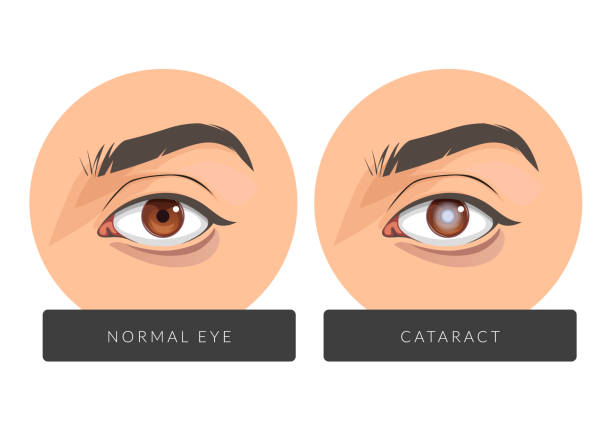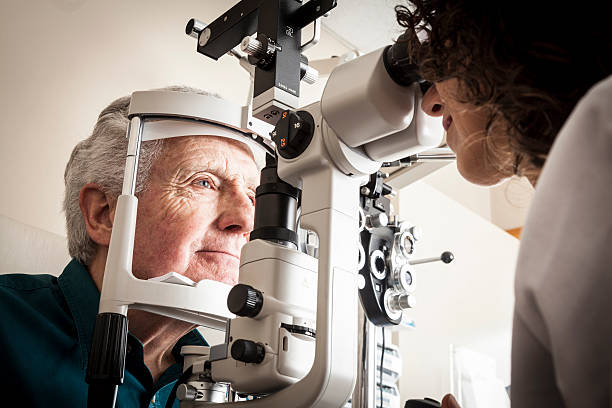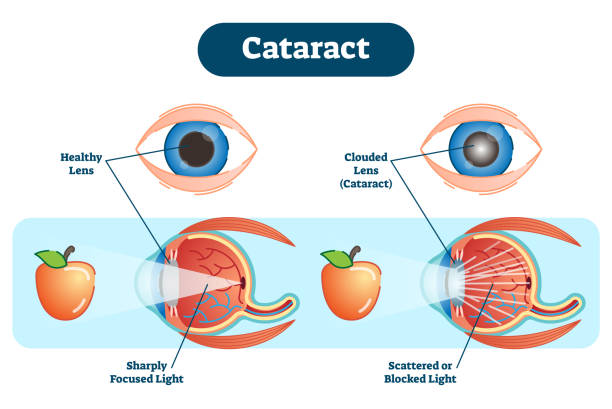What Are Cataracts?
Cataracts are one of the most common eye conditions worldwide, especially as people get older. They happen when the lens of your eye becomes cloudy, making it hard to see clearly. The lens normally works like a camera lens—bending and focusing light so you can see sharp images at different distances. But with cataracts, the lens slowly becomes less clear over time. This clouding causes your vision to look blurry, hazy, or dim, which can make daily activities like reading, driving, or recognizing faces more difficult.
According to the World Health Organization, cataracts are the leading cause of blindness across the globe, affecting millions of people each year. The good news? They are highly treatable, and modern treatments are very safe and effective. With early diagnosis and proper care, many people are able to protect their vision and enjoy a better quality of life well into their later years.
What Causes Cataracts?
Cataracts usually develop slowly as part of the natural aging process. Over time, proteins in the eye’s lens break down and clump together, which causes the lens to become cloudy. This is why they are more common in older adults. But age is not the only factor. They can also be caused or worsened by several other issues, including:
- Age: Most people over 60 will experience some level of cataract formation, even if they don’t notice vision problems right away.
- Genetics: If cataracts run in your family, you may be more likely to develop them earlier in life.
- Health conditions: Diabetes, high blood pressure, and other medical problems can raise your risk of cataracts. Certain medications, like steroids, can also play a role.
- Eye injuries: Trauma, past eye surgery, or inflammation can sometimes lead to cataract development.
- UV exposure: Spending lots of time in the sun without proper eye protection may speed up the clouding of the lens.
- Lifestyle factors: Smoking, poor diet, and heavy alcohol use can damage eye health and contribute to cataracts.
While you can’t always prevent it completely, knowing these causes can help you make smart choices for healthier vision. Wearing sunglasses, eating nutrient-rich foods, and keeping medical conditions under control are simple steps that may slow down cataract progression.

Common Symptoms of Cataracts
Cataracts don’t usually appear overnight. Instead, they develop gradually. At first, you may not notice any changes. But over time, symptoms can include:
- Blurry or cloudy vision
- Trouble seeing at night
- Sensitivity to light or glare
- Seeing halos around lights
- Fading or yellowing of colors
- Double vision in one eye
- Needing frequent changes in your glasses prescription
If you notice one or more of these symptoms, it may be time to schedule an eye exam. Early detection can make treatment more effective.
Types of Cataracts
Not all cataracts are the same. Doctors classify them into several types based on where they form in the eye:
1. Nuclear Cataracts
These form in the center of the lens, also called the “nucleus.” At first, a nuclear cataract may make your close-up vision seem better for a short time, a change sometimes called “second sight.” But this effect doesn’t last. As the cataract grows, the center of the lens becomes more cloudy and dense. Colors may start to look yellow or brown, making it harder to tell shades apart. Reading small print, driving at night, or seeing details in low light often becomes more difficult. Nuclear cataracts are the most common type linked with aging and tend to worsen slowly over the years.
2. Cortical Cataracts
These start at the outer edges of the lens and slowly work their way inward, forming wedge-like shapes that look a bit like spokes on a wheel. As the cloudy areas move toward the center, they begin to scatter light entering the eye. This often causes problems with glare, making it uncomfortable to drive at night or look at bright lights. Cortical cataracts can also reduce contrast, so it becomes harder to see clear differences between light and dark areas. People with this type of cataract may find it difficult to read, recognize faces in dim lighting, or handle tasks that require sharp vision.
3. Posterior Subcapsular Cataracts
These form at the back of the lens, in the area that helps focus light as it enters the eye. Because of their position, posterior subcapsular cataracts often interfere with vision more quickly than other types. They can make reading small print difficult, even with glasses, and may cause strong glare or halos around lights. Bright sunlight or headlights at night can feel especially uncomfortable, which is why many people with this type of cataract struggle with night driving. Posterior subcapsular cataracts are more common in people with diabetes, those who take steroid medications, or individuals who have had previous eye injuries.
4. Congenital Cataracts
Some people are born with cataracts, while others may develop them during childhood. These cataracts are much less common than those that appear with age, but they can have a serious impact on a child’s vision and overall development. In many cases, congenital cataracts are caused by genetics, infections during pregnancy, or certain health conditions passed from parents to children. Because clear vision is so important for learning and growth, early detection is key. If left untreated, congenital cataracts can lead to lazy eye (amblyopia) or permanent vision loss. Doctors often recommend surgery at a young age to remove the cloudy lens and help the child’s vision develop normally.
Knowing the type of cataract can help eye doctors recommend the right treatment.

How Cataracts Are Diagnosed
Diagnosing cataracts usually involves a simple eye exam. Your eye doctor may perform:
- Visual acuity test: Reading letters on a chart to measure how clearly you see.
- Slit-lamp exam: Using a microscope to check the lens of your eye.
- Retinal exam: Looking at the back of your eye to rule out other conditions.
These exams are painless and give your doctor a clear picture of your eye health.
Treatment Options for Cataracts
The best treatment for cataracts depends on how advanced they are and how much they affect your daily life.
Early Stages
In the beginning, your doctor may suggest:
- Stronger prescription glasses or contact lenses
- Brighter lighting at home
- Anti-glare sunglasses
- Magnifying lenses for reading
These adjustments can help delay surgery and keep your vision comfortable.
Cataract Surgery
When cataracts start to interfere with your daily activities—like driving, reading, or recognizing faces—surgery is usually the next step.
Cataract surgery is one of the safest and most effective procedures in modern medicine. During the surgery:
- The cloudy lens is removed.
- A clear artificial lens, called an intraocular lens (IOL), is placed inside the eye.
Most patients notice improved vision within a few days. According to the American Academy of Ophthalmology, cataract surgery has a very high success rate, with more than 9 out of 10 people regaining clear vision.
Can Cataracts Be Prevented?
While you can’t stop aging, you can take steps to lower your risk or slow cataract progression:
- Wear sunglasses with UV protection when outdoors.
- Eat a diet rich in antioxidants like vitamin C, vitamin E, and beta-carotene.
- Quit smoking and limit alcohol intake.
- Manage health conditions like diabetes.
- Get regular eye exams, especially after age 40.
These habits not only protect your eyes but also support your overall health.
Living with Cataracts
If you’ve been diagnosed with cataracts, it doesn’t mean your quality of life has to suffer. With early care and lifestyle adjustments, many people live comfortably for years before needing surgery.
Some helpful tips include:
- Keeping your home well-lit
- Using larger text on digital devices
- Avoiding night driving if glare is a problem
- Scheduling regular check-ups with your eye doctor
Your doctor can also guide you on when it’s the right time to consider surgery.

When to See a Doctor
You should schedule an eye exam if you:
- Have blurry or cloudy vision that affects daily tasks
- Notice halos, glare, or fading colors
- Struggle with night driving
- Experience frequent changes in your glasses prescription
Don’t wait until vision loss becomes severe. Early diagnosis leads to better treatment outcomes.
Cataracts and Other Eye Conditions
Sometimes cataracts occur alongside other eye issues like glaucoma or macular degeneration. This makes regular check-ups even more important. If you have a family history of eye disease, let your doctor know. They can watch for early signs and help protect your vision.
Final Thoughts: Protecting Your Vision
Cataracts are common, but they don’t have to steal your sight. By learning the causes, recognizing the early symptoms, and exploring treatment options, you can take control of your eye health and protect your vision. The earlier cataracts are found, the easier they are to manage. Even small lifestyle changes—like wearing UV-protective sunglasses, eating nutrient-rich foods, and getting regular check-ups—can make a big difference in slowing their progression.
If you think you might have cataracts—or if you simply want to keep your eyes healthy—schedule a comprehensive eye exam with an eye care professional. Regular exams can catch problems before they worsen and give you peace of mind. Your vision is one of your most valuable assets, helping you stay independent, active, and connected with the world around you. Taking action today can help preserve clear vision for years to come.
👉 Have you or someone you know experienced cataracts? Share your story in the comments below. Your experience could help others going through the same journey!

